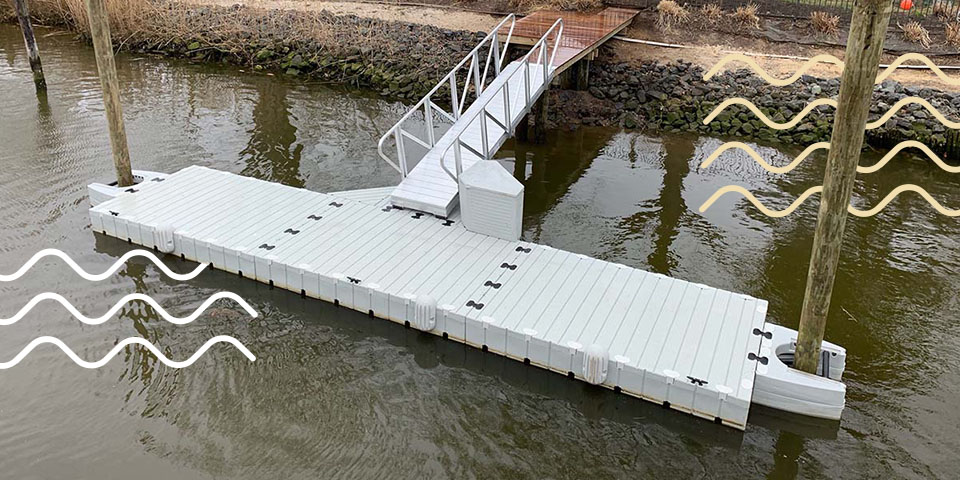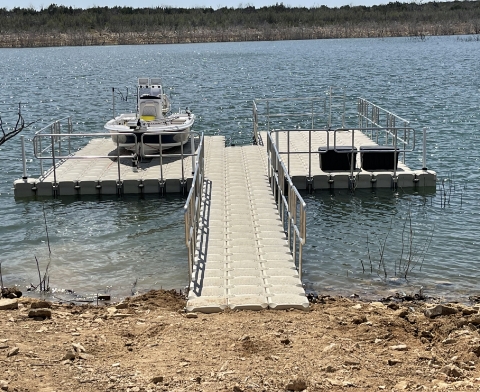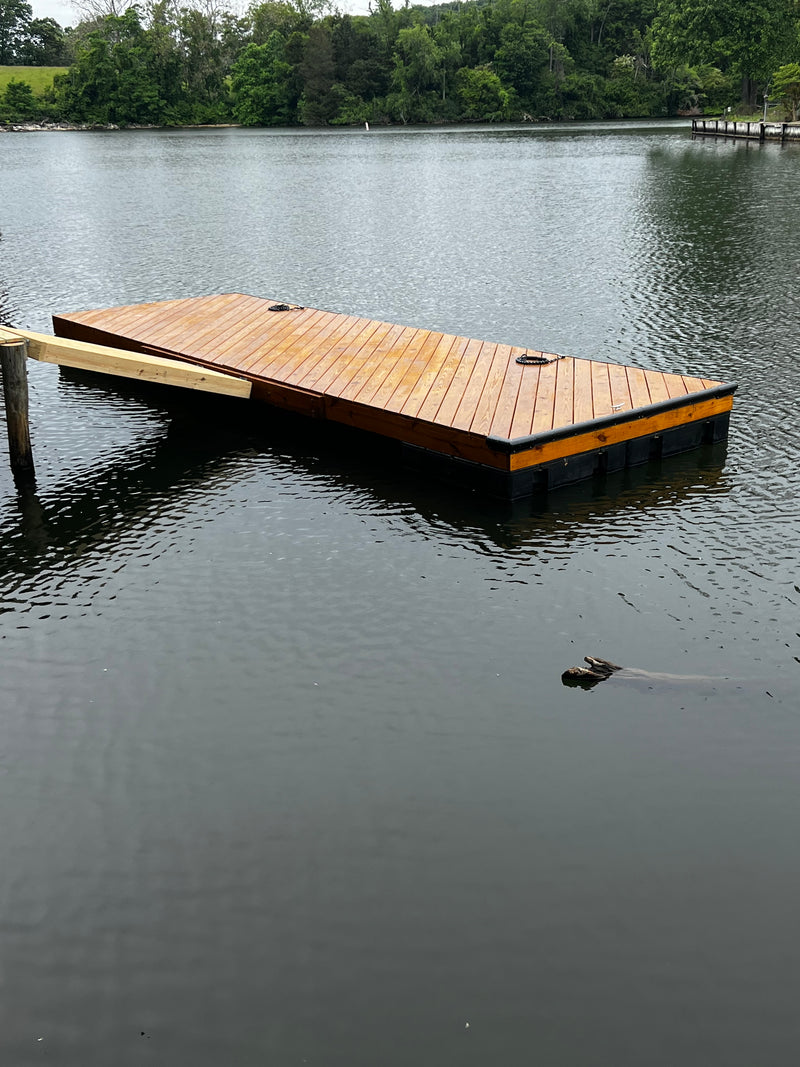Upgrade Your Beachfront With Long Lasting Floating Docks
Upgrading your beachfront with sturdy floating docks can dramatically boost both capability and appearances, offering a versatile service for various water activities. With a range of materials available, including low-maintenance alternatives and conventional timber, choosing the best dock can complement your individual design and fulfill useful requirements.
Benefits of Floating Docks
Floating docks offer a wide range of benefits that improve their charm for different maritime applications. Among the primary advantages is their versatility to transforming water levels - floating dock company. Unlike typical fixed docks, floating docks fluctuate with the trend, making certain regular accessibility for boats and boat despite environmental conditions. This attribute dramatically decreases the threat of damages to vessels, as they stay safely tied even during variations in water deepness.
Additionally, floating docks are less complicated to transfer and set up, giving versatility for seasonal or momentary use. Their modular style enables modification to fit specific requirements, whether for private marinas, property watersides, or business applications.
Furthermore, floating docks produce marginal disruption to the marine atmosphere, maintaining neighborhood environments and minimizing the chance of erosion. They additionally offer improved safety and security and security for customers, as their buoyant nature supplies a more forgiving surface than inflexible frameworks.
Furthermore, floating docks can facilitate a diverse series of tasks, such as angling, swimming, and leisure boating, making them a beneficial property for beachfront advancement. Their versatility and usefulness make floating docks a favored option for a range of maritime jobs.
Choosing the Right Products
Choosing proper products for floating docks is vital to their long life, performance, and total effectiveness. When choosing products, consider factors such as ecological exposure, maintenance requirements, and structural honesty. Usual products include timber, plastic, light weight aluminum, and composite alternatives, each offering unique advantages and downsides.
Timber, while cosmetically pleasing, calls for routine upkeep to avoid rot and degeneration. Pressure-treated timber can improve toughness, yet it might still succumb to water damages over time. Plastic drifts, frequently made from high-density polyethylene, are resistant to rust and require minimal maintenance, making them an appealing option for low-maintenance applications.
Aluminum is an additional feasible option, known for its toughness and lightweight residential properties. It is resistant to corrosion and can hold up against rough weather conditions, although it may be more expensive than various other materials. Compound products integrate the most effective attributes of timber and plastic, providing a low-maintenance and resilient option that imitates the look of wood without the connected disadvantages.
Inevitably, the option of material should align with the meant usage, environmental considerations, and spending plan constraints, making sure a sturdy and functional floating dock that satisfies your certain needs.
Installation Process Introduction
The successful installation of a drifting dock relies upon careful preparation and execution, making certain that it runs effectively in its desired setting. The very first action includes analyzing site conditions, consisting of water deepness, shoreline functions, and prevailing weather patterns, which will educate the dock design and anchoring system.
Adhering to the site assessment, the next stage is to prepare the floating dock parts. This includes constructing the structure, protecting drifts, and attaching any kind of required equipment. It is essential to guarantee that all connections are robust and water-resistant to endure aquatic conditions.
Once the dock is put together, the installation process starts with positioning the dock in the water. This can entail a crane or other training equipment, particularly for larger structures. Appropriate placement is necessary for performance and safety and security.

Upkeep Tips for Durability
Routine upkeep is vital for making certain the longevity and optimal efficiency of a floating dock. To accomplish this, begin with regular assessments at least two times a year, concentrating on the honesty of the Our site dock's framework, consisting of the flotation gadgets and connecting equipment. Seek indications of corrosion, wear, or damage, and address any type of issues immediately to stop more damage.
Cleaning up is another essential element of upkeep. Get rid of debris, algae, and barnacles from the dock's surface area to prevent unsafe conditions and keep visual appeal. Use a soft brush and a moderate detergent to prevent damaging the dock's materials.
In addition, ensure that the dock is correctly secured and secured to hold up against seasonal adjustments in water degrees and climate condition. look at here now Examine the anchoring system for stability and make changes as necessary.
Enhancing Your Outside Visual
To create an aesthetically attractive outdoor room, incorporating a floating dock can considerably enhance the overall visual of your beachfront building. Floating docks are not only functional but can additionally work as a striking focal point that enhances the natural environments - dock company. Readily available in different products and designs, these docks can be tailored to match your home's architectural style and landscape
The addition of ornamental components, such as incorporated lights or fashionable barriers, better raises the dock's visual appeal. Consider utilizing natural timber coatings, which mix flawlessly with the atmosphere, or choosing contemporary products like aluminum or composite decking that use a sleek, modern appearance.
Purposefully positioning planters or seating locations on or around the dock can develop inviting areas that urge relaxation and pleasure of beachfront sights. Furthermore, incorporating shades and appearances that balance with your landscape will certainly create a cohesive visual throughout your outdoor area.

Final Thought

Upgrading your beachfront with resilient floating docks can significantly improve both performance and appearances, providing a flexible remedy for numerous water activities. Unlike typical fixed docks, floating docks surge and fall with the trend, guaranteeing consistent access for watercrafts and boat no matter of environmental conditions.Picking suitable products for floating docks is crucial to their durability, performance, and general efficiency.Once the dock is constructed, the installation process starts with placing the dock in the water.In summary, floating docks deal various advantages, including adaptability to water level modifications and a range of material options.
Comments on “Floating Docks: The Smart Selection for Modern Waterfront Living and Leisure”